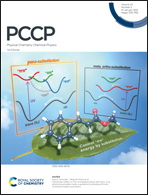Theoretical study of the adsorption of analgesic environmental pollutants on pristine and nitrogen-doped graphene nanosheets†
Abstract
Interactions of the analgesic medications dextropropoxyphene (DPP, opioid), paracetamol (PCL, nonnarcotic), tramadol (TDL, nonnarcotic), ibuprofen (IBN, nonsteroidal anti-inflammatory drug (NSAID)), and naproxen (NPX, NSAID) with pristine graphene (GN) and nitrogen-doped GN (NGN; containing only graphitic N atoms) nanosheets were explored using density functional theory (DFT) in the gas and aqueous phases. Calculations in the aqueous phase were performed using the integral equation formalism polarized continuum model (IEFPCM). Calculated geometry-optimized structures, partial atomic charges (determined using Natural Bond Orbital analysis), highest occupied molecular orbital (HOMO)-lowest unoccupied molecular orbital (LUMO) energy gaps, work functions (determined using time-dependent DFT), and molecular electrostatic potential plots showed that the adsorption process is physical in nature (viz. physisorption), primarily due to noncovalent π–π and van der Waals interactions. In addition, calculated adsorption energies (ΔEad) were exergonic, indicating that formation of the analgesic/GN and analgesic/NGN complexes is thermodynamically favorable in the gas (ΔEad values for analgesic/GN and analgesic/NGN were in the range of −66.56 kJ mol−1 to −106.78 kJ mol−1) and aqueous phases (ΔEad values for analgesic/GN and analgesic/NGN complexes were in the range of −58.75 kJ mol−1 to −100.46 kJ mol−1). Generally, for GN and NGN, adsorption was more endergonic in the aqueous phase by as much as +10.41 kJ mol−1. Calculated solvation energies (ΔEsolvation) were exergonic for all analgesic/GN complexes (ΔEsolvation values were in the range of −56.50 kJ mol−1 to −66.17 kJ mol−1) and analgesic/NGN complexes (ΔEsolvation values were in the range of −77.26 kJ mol−1 to −87.96 kJ mol−1), with analgesic/NGN complexes exhibiting greater stability in aqueous solutions (∼20 kJ mol−1 more stable). In summary, the results of this theoretical study demonstrate that the adsorption and solvation of analgesics on GN and NGN nanosheets is thermodynamically favorable. In addition, generally, analgesic/NGN complexes exhibit higher adsorption affinities and solvation energies in the gas and aqueous phases. Therefore, GN and NGN nanosheets are potential adsorbents for extracting analgesic contaminants from aqueous environments such as aquatic ecosystems.



 Please wait while we load your content...
Please wait while we load your content...